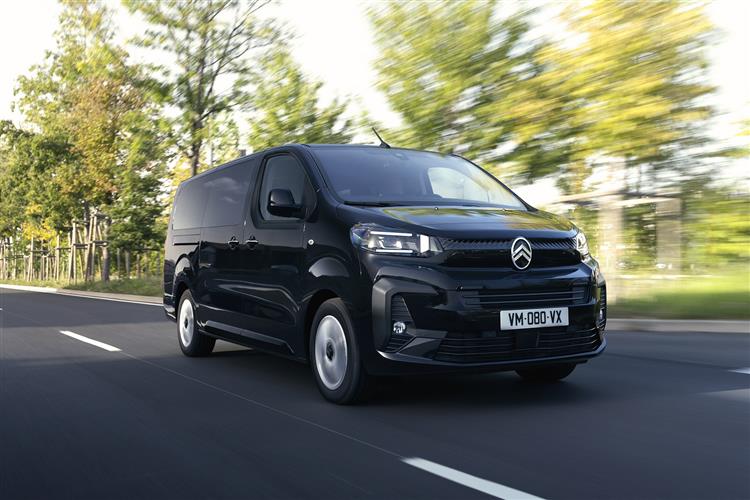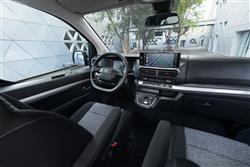How will you view?
This is a sample, showing 30 seconds of each section.
CHEVVY VOLT (some text hidden) SECTIONED_new_citroenespacetourer_2024
By Jonathan Crouch
In this improved e-SpaceTourer, the double-Chevron brand brings us a more credible version of its large BEV People Carrier. Jonathan Crouch takes a look.
Ten Second Reviewword count: 64
There are more options than you might expect for full-electric power with really large MPVs. Here's Citroen's take on this concept, the e-SpaceTourer, here usefully improved with a larger 75kWh battery. It still won't go particularly far on a single charge, but it'll seat up to nine, help you move house or function as an executive minibus. All without using a drop of fuel.
Backgroundword count: 172
Very soon, no segment of the automotive market will lack full-EV model options. One of these sectors lately gaining improved BEV models has been that for large People Carriers. This isn't really because manufacturers think this to be much of a potential growth area. It's more because really big MPVs are always based on the kind of mid-sized vans that car makers, pressurised by governments, are starting to offer in full-electric form these days. The Mercedes Vito, Peugeot Expert, Vauxhall Vivaro, Toyota Proace and Citroen Dispatch LCVs can all be had in full-EV form. So their MPV counterparts (the Mercedes V-Class, the Peugeot Traveller, the Vauxhall Vivaro Life, the Toyota Proace Verso and the Citroen Space Tourer) also get the full-battery treatment. The Peugeot, the Vauxhall, the Toyota and the Citroen are essentially the same underneath, sharing the same Stellantis Group powertrain; it's the Citroen model, badged the 'e-SpaceTourer' that's the subject of this review, originally launched in 2020, then enhanced three years on to create the car we look at here.
Driving Experienceword count: 214
Why Citroen offered the original version of this model with a 50kWh battery more suited to an EV supermini is difficult to understand. It's also difficult to see why the brand still sells the e-SpaceTourer in this form, a guise in which range is limited to just 136 miles. Far more usable is the 215 mile range of the added 75kWh model that most will want (about the same as the class-leading Mercedes EQV). Both these two types of lithium-ion battery are mated to the same 136bhp electric motor, which now works with a new three-stage regenerative braking system controlled by paddles behind the steering wheel. Using this MPV is straightforward. You turn the key in the ignition, wait for the starting beep, then flick the gear toggle into Drive. There's a drive-mode selector that allows drivers to switch between ECO, NORMAL and POWER modes. Top speed is just 84mph. Through the corners, as you would expect, there's plenty of body roll if, rather unwisely, you start throwing the thing about. If you can ignore both that and the slightly vague steering and find yourself absolutely having to push on, you'll find that there's reasonable grip and traction. The power steering is now electrically assisted (instead of electro-hydraulic) to reduce effort and improve manoeuvrability.
To see the full road test text contact us on 0330 0020 227
Pictures (high res disabled)

.jpg)
|
.jpg)
|
.jpg)
| |||
.jpg)
|

|
Statistics (subset of data only)
Min |
Max |
|
Price: |
£37,990.00 (At 21 Mar 2024) |
£55,130.00 (At 21 Mar 2024) |
Insurance group 1-50: |
33 |
35 |
Max Speed (mph): |
84 (50kWh) |
|
0-62 mph (s): |
12.1 (50kWh) |
|
Electric WLTP-Rated Driving Range (miles): |
139 |
|
Length (mm): |
4950 |
|
Width (mm): |
1920 |
|
Height (mm): |
1900 |
|
Boot Capacity (l): |
2381 |
|
Scoring (subset of scores)
Category: Hybrid, Plug-in, Electric & Hydrogen
| Performance | |
| Handling | |
| Comfort | |
| Space | |
| Styling, Build, Value, Equipment, Depreciation, Handling, Insurance and Total scores are available with our full data feed. | |



